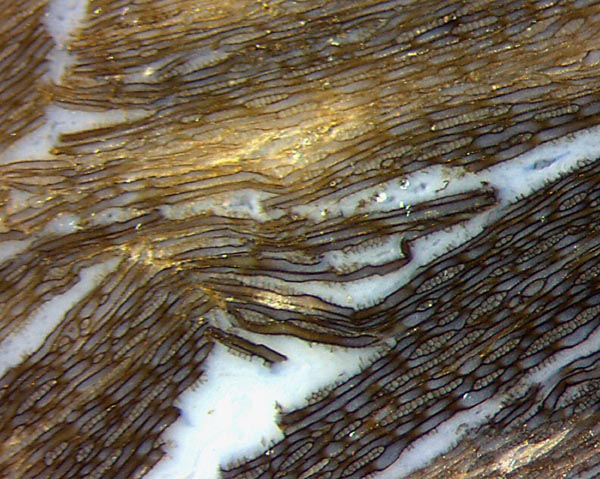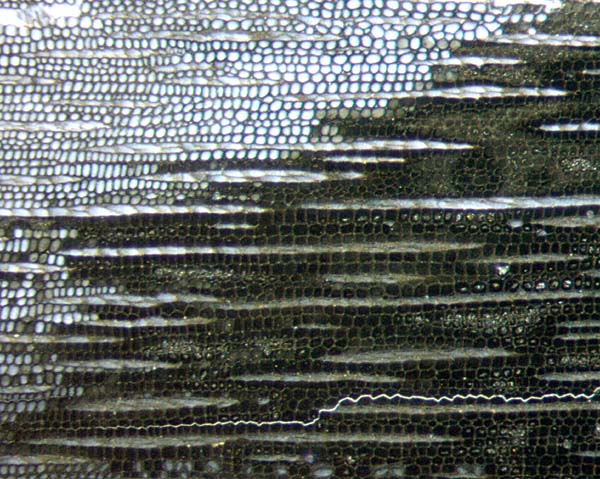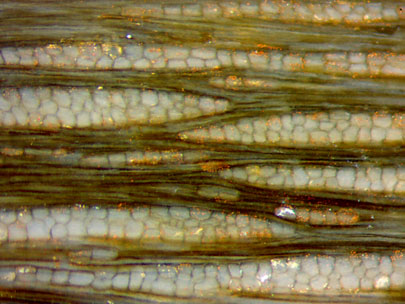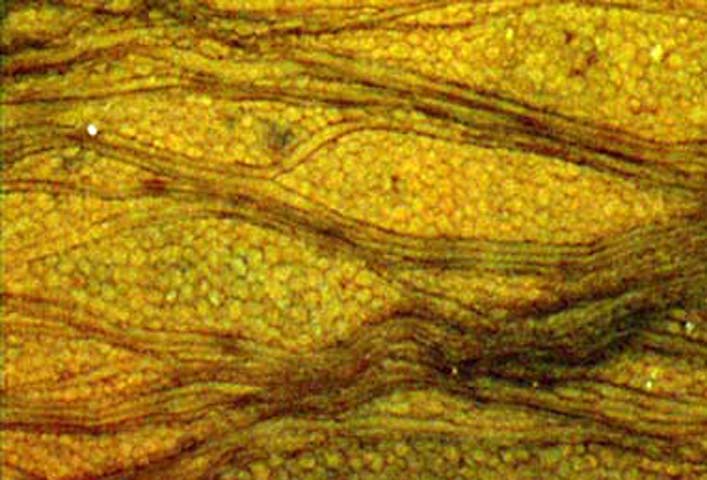Pith rays in Permian wood
Looking for
pith rays in fragments of silicified wood is an easy means of
selecting the less-common specimens from a large majority of the
usually less interesting
samples summarized as
Dadoxylon. Three
wood samples from the Lower
Permian Doehlen basin
with quite different aspect are shown here. One of them, although most
probably Dadoxylon,
is interesting for several reasons nevertheless.


Figs.1,2: Coniferous wood with narrow pith rays, one or two cells wide,
among wood tracheids.
Picture widths 2.5mm,
same scale. Sample W/55.
Fig.1: Stem cross-section, slightly inclined, therefore pith rays cut
not quite lengthwise.
Fig.2: Lengthwise section of deformed degraded wood, pith rays visible
as cross-sections, some of them torn asunder.
It took some effort to
refute the favourite interpretation of
this black
petrified wood as fossil charcoal. Careful inspection of
the sample revealed wood tracheids bent like limp tubes as in Fig.2.
This and other evidence shows that the wood had become degraded and
torn while still soft, then silicified.
As a remarkable fact seen in Fig.2, the cracks chose always a path
through the pith rays and their cells, then between the tracheids but
never within.
Concerning crack propagation, there seem to have been subtle
differences in fracture toughness of the degraded
wood before
silicification: The uncommonly well seen narrow crack in Fig.1 avoided
the pith rays but took a long multiply kinked path between the
tracheids.


Wood which had got squeezed before silicification is seen here:
Figs.3,4: Wood of uncertain affiliation,
pith rays 1-3-(5) cells wide, among collapsed wood tracheids.
Picture widths 1.7mm, same scale as above. Sample W/45.
The
pith ray cross-sections in Fig.3 may be compared to the much smaller
ones in Fig.2. Other than in Fig.2, the tracheids are collapsed in
Fig.3, as seen on the wood cross-section in Fig.4.
Here the pith ray cells, too, had become compressed
but less conspicuously deformed. Their size makes them appear more
similar to calamites rather than to conifers.
Despite
of the random arrangement of wood tracheids in Fig.5, there seems to be
no deformation involved. Perpendicular to this tangential cut plane, on
the cross-section of the trunk (Fig.6),
the radial files of wood and pith extend straight towards
the edge of the sample. Faintly
seen is a "brick wall
aspect"
of the pith in Fig.6, similar
as in [1].
The big pith rays indicate a calamite
affiliation. No significant divergence of the radial files is apparent
on the available cross-section, hence it must be a fragment of a rather
big trunk.


Figs.5,6: Wood similar
as Arthropitys,
pith
rays up to about eight cells wide, among wood tracheids.
Picture widths 3mm, 1.5mm,
same scale as above. Sample Bu7/20.
Fig.6: Cross-section of
the
trunk with tracheids and lengthwise cut pith
rays with faintly seen "brick
wall aspect".
Fig.5 (far left): Tangential section of the trunk
showing cross-cut pith
rays and
lengthwise cut wood tracheids seen as randomly curved tubes. Detail of
a picture
taken by H.
Sahm.
The find of this sample
at the "maggot stone" locality in the
Döhlen basin in 2000 had led R.
Kretzschmar (Chemnitz)
to the assumption that there were not yet unearthed big tree
trunks with large pith rays. His assumption,
made public at www.kieseltorf.de,
really led to the
discovery of the world's biggest calamite tree trunk in Chemnitz. The
story of that discovery and subsequent developments
have been told in Fossil
Wood News 15.
Samples: W/55(ca.0.6kg),
W/45(ca.40g): found in 1991 at
Wilmsdorf, Possendorf near Dresden; Bu7/20(ca.0.8kg), found in 2000 at
Burgk/Kleinnaundorf near
Dresden.
H.-J.
Weiss 2019
[1] R.
Rößler, R. Noll:
Der permische versteinerte Wald von Araguaina /Brasilien.
Veröff. Mus. Naturk. Chemnitz 25(2002),
5-44. Figs.46, 49, 70, 77.
|

|
 37 37 |

 37
37






 37
37